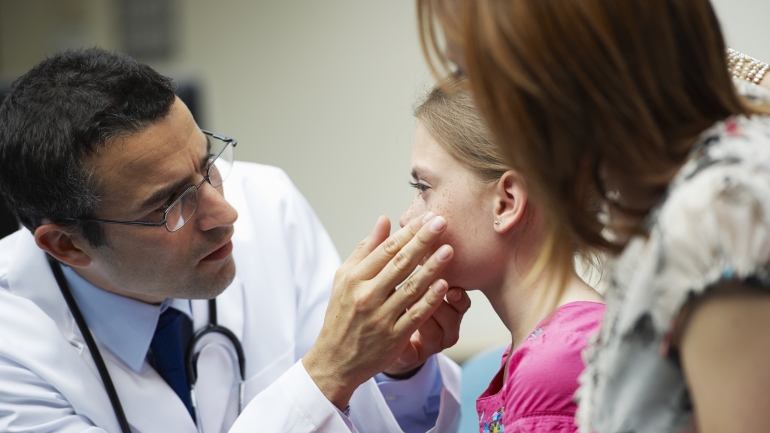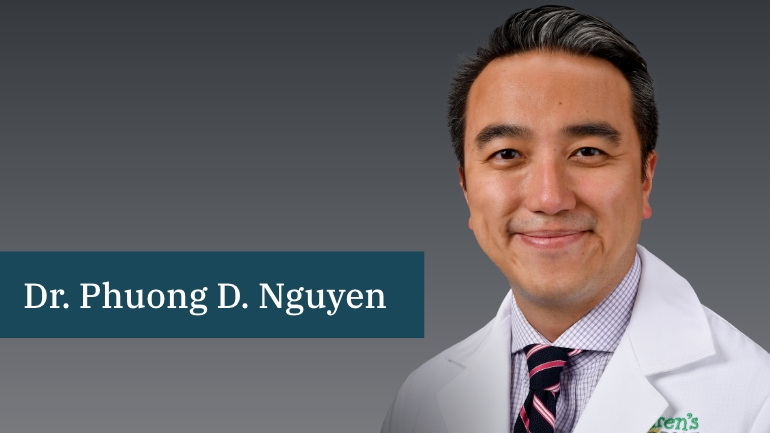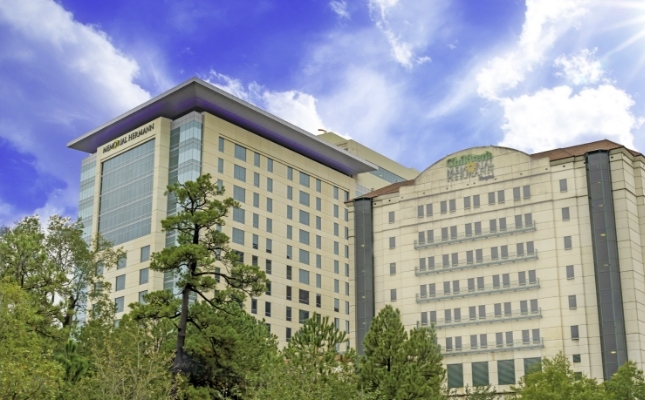Facial paralysis can be physically and emotionally debilitating for anyone. Facial muscles are responsible for a wide range of social interactions, emotional expressions and facial function. But facial palsy can be especially devastating for children and adolescents. It can have a profound effect on their quality of life, potentially contributing to depression and poor self-esteem.
For physicians, management of facial palsy in children can also be particularly challenging, given the need to address additional psychosocial and parental considerations, future growth potential and anatomical concerns.
In Advance podcast Episode 6: “A New Approach to Pediatric Facial Reanimation Evaluation and Treatment,” affiliated Children’s Memorial Hermann Hospital pediatric plastic surgeon Phuong D. Nguyen, MD, discusses the etiologies underpinning pediatric facial paralysis and the array of nonsurgical and surgical treatment options available to patients. Here, Advance takes a deeper dive into his team’s novel algorithmic approach to decision-making regarding treatment for each patient.
Dr. Nguyen is an associate professor of pediatric plastic and craniofacial surgery at McGovern Medical School at UTHealth Houston and is the chief of Pediatric Plastic Surgery and director of Craniofacial Surgery at Children's Memorial Hermann Hospital.
He has specialized expertise in facial reanimation techniques, having completed seven years of training in general surgery, three years of training in plastic surgery and an additional year of training in craniofacial and pediatric plastic surgery. He has been in practice for seven years and has published several articles about the basic science and clinical aspects of treatment of facial palsy and facial nerve regeneration.
Determining the appropriate treatment begins with an evaluation of the patient, to determine the etiology of the paralysis, duration of symptoms and laterality of the paralysis. But as Dr. Nguyen explains, there are other, very important considerations: the goals and expectations of the patient, or of a pediatric patient’s parent, as well as the patient’s ability and willingness to fully participate in postoperative exercises and rehabilitation.
Evaluation
Dr. Nguyen says evaluation for treatment of facial palsy begins with a history and physical examination to establish timing and chance of recovery without intervention, and also laterality of the paralysis. “We start by asking ourselves a few important questions: Why is there a palsy? Is it bilateral or unilateral? When did the symptoms first occur? And what has been the progression of acuity and symptoms?”
Pediatric palsy is either congenital or acquired. Congenital causes comprise less than 10% of cases and include birth trauma and syndromic facial palsy, such as Moebius syndrome. The most common cause of acquired facial palsy in the pediatric population is Bell’s palsy, or idiopathic facial paralysis, which causes up to 40% to 50% of all pediatric cases.
As a pediatric plastic surgeon affiliated with Children’s Memorial Hermann Hospital, Dr. Nguyen says a large portion of the cases he sees are congenital. “I see patients at Memorial Hermann who can be very young, some diagnosed as neonates, either with something relatively common like asymmetric crying facies, or as part of a syndrome, like a hemifacial microsomia or a Goldenhar syndrome,” he says.
Intervention
Interventions are classified according to their duration of symptoms: immediate/acute (within 72 hours), subacute (72 hours to 12 months) and chronic (>12 to 18 months).
Acute onset might be caused by a tumor resection, a trauma (such as blunt injury or a laceration) or acute onset of Bell’s palsy. Immediate interventions focus on re-establishing nerve conduction. “We see a lot of trauma here at Memorial Hermann,” says Dr. Nguyen. “If a patient has cut a nerve, for instance, we must quickly try to locate those nerve endings and repair them. Generally speaking, enough degeneration can occur within 72 hours to prevent stimulation of the distal end of those nerves. Some of those nerves can be extremely small. But being able to stimulate that distal nerve can be very important in maximizing success of being able to put the ends back together.”
Dr. Nguyen considers subacute cases to be especially challenging to manage. “With Bell’s palsy we know that there can be some level of spontaneous improvement, so we just have to follow them. If they're getting better, then it's a watch and wait. If they're getting worse, we have a timeline, because we want to keep their existing facial musculature alive. After approximately 18 months, if there's no nerve going into it, that muscle atrophies. And no matter what you do, you can't use that muscle again.
“In these situations, we might enlist a ‘babysitter nerve,’ a nerve from a different part of the body, to provide an input into those muscles, to keep the muscle tone alive. It babysits those distal nerves and the muscles while we put in something that’s a more correct input, like the opposite facial nerve.”
A chronic patient is one who has had an injury with zero recovery for at least 12 to 18 months. Dr. Nguyen says he views chronic cases as less complex. “You know you’re not trying to preserve native muscle; you’re trying to replace muscle,” he says. “In these cases, we might perform free gracilis muscle transfer (FGMT), a surgery which involves bringing in the gracilis muscle from the leg to perform the facial muscle function that was lost.”
Patient-Centered Approach
Dr. Nguyen emphasizes the importance of understanding the patient’s treatment goals and expectations (or a pediatric patient’s parent’s goals and expectations for their child) before creating the patient’s plan of treatment.
“Our job as physicians is to determine the right procedure for the right patient,” he explains. “That's a general way of saying we must understand the patient's desire, desired rehabilitation phase, desired timeline, and what they want out of it. We must be aligned with the patient in terms of those expectations before embarking upon any surgery. I think a key marker for success is figuring out what the patient wants and when they want it.”
To illustrate his point, he offers two patient examples. “I had a a young female patient who wanted to have a smile in time for a major event in her life. Due to Bell's palsy, half of her face had been paralyzed for at least several years. She was seeking a quick recovery. I discussed different options with her and her parents, and she ultimately decided on an option that would give her a smile within several months, a dual innervated gracilis muscle transfer.”
“In contrast, I had a young male patient who was an athlete. He did not want any downtime or any scars on his legs (the location from which we would have borrowed the gracilis muscle). On him, I performed a Labbé procedure, a lengthening temporalis myoplasty (LMT), in which we used enlisted and extended the chewing muscles at his temple. He was able to smile by contracting that muscle. That seemed to be the right pathway for him.”
Another predictor of a patient’s success is the patient’s commitment to and participation in postoperative rehabilitative therapy, which begins three weeks postoperatively. “To maximize and optimize the result, the patient must do the work, and it’s a marathon, not a sprint, ” he says. “We take a multidisciplinary approach to caring for patients at Memorial Hermann. If a patient’s not putting the time in, our therapist will ask me to reinforce the importance of the therapy to the patient. It’s that level of communication that really gives you the best possible outcome.”
A Full Array of Options
One of the benefits of having specialized expertise in facial reanimation is being able to offer patients a full array of surgical and nonsurgical treatment options. “At Memorial Hermann, we offer all of these different options to patients, tailored to what makes sense in their lives,” says Dr. Nguyen. “I would say many other programs take a one-size-fits-all approach. But given the experience of our team, we are able to offer a full gamut of treatment options.”
To learn more about Dr. Nguyen’s team’s innovative algorithmic approach to the treatment of facial palsy, read “Pediatric facial reanimation: An algorithmic approach and systematic review,” originally published in the Archives of Plastic Surgery.
To refer a patient, call the Texas Cleft-Craniofacial Team and Pediatric Plastic Surgery Clinic at (832) 325-7234. Visit here to learn more about the Pediatric Plastic and Reconstructive Surgery Program at Children’s Memorial Hermann Hospital and McGovern Medical School at UTHealth Houston.




